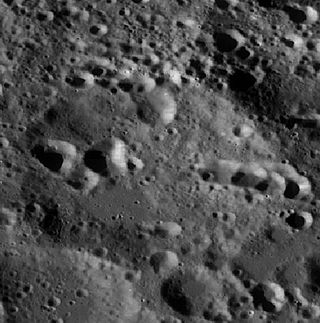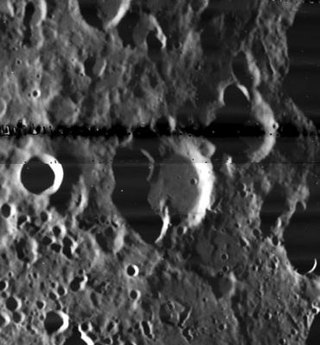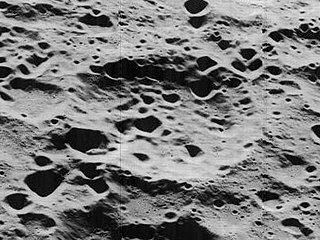
Boss is a lunar impact crater that is located along the northeast rim of the Moon's near side. Due to its location, the crater is viewed from the side by observers on the Earth, and its visibility is subject to libration effects. It was named by the IAU in 1964 for astronomer Lewis Boss.

Becquerel is a lunar impact crater that lies in the northern hemisphere on the far side of the Moon. This is an ancient and heavily worn formation that is now little more than an irregular buri in the surface. The outer rim has been worn and reshaped until it forms a rugged, mountainous region around the flatter interior.

Bragg is an ancient lunar impact crater that is located on the far side of the Moon, just beyond the northwest limb. This formation has been heavily eroded and reshaped by subsequent impacts, leaving an irregular depression in the surface. The most intact portion of the rim is along the western face, while the northern and eastern rim has been nearly worn away and is overlaid by several smaller craters. The most notable of these is Bragg H, which lies across the east-southeastern rim.

Berkner is a lunar impact crater that is located on the far side of the Moon, just past the western limb. It is attached to the east-southeast rim of the crater Parenago. Just to the south is the Robertson, and to the southeast is Helberg.

Cusanus is a lunar impact crater that is located near the northeastern limb of the Moon. In this location the crater appears very foreshortened when observed from the Earth, and its visibility is affected by libration. The northern rim of Cusanus is nearly joined to the south-southeastern rim of the larger crater Petermann. To the west is Baillaud and to the southeast is Hayn.

Campbell is a large lunar impact crater that is located in the northern hemisphere on the far side of the Moon. It lies to the southwest of the walled plain D'Alembert, an even larger formation. If Campbell were located on the near side of the Moon as seen from the Earth, it would form one of the largest visible craters, being slightly larger than Schickard. It is bordered by several craters of note, with Wiener to the southwest, Von Neumann just to the south, Ley overlying the southeast rim, and Pawsey to the west.

Chapman is a lunar impact crater that lies just beyond the northwest rim of the Moon, on the far side as seen from the Earth. It lies to the northeast of the crater Rynin, and southward of the large walled plain Poczobutt.

Chevallier is a lunar impact crater that is located in the northeastern part of the Moon's near side, about a crater diameter east-southeast of the prominent crater Atlas. To the south-southeast of Chevallier is the flooded crater Shuckburgh. Chevallier was named by the IAU in 1935.

Chandler is a lunar impact crater in the northern hemisphere, on the Moon's far side. It lies to the southeast of the large walled plain D'Alembert, and southeast of the slightly smaller Chernyshev crater.

Douglass is a lunar impact crater on the far side of the Moon. It lies to the southwest of the crater Frost and south-southwest of the large walled plain Landau.

Delporte is a lunar impact crater on the far side of the Moon. It overlies part of the northwestern rim of the huge walled plain Fermi, and the crater Litke is nearly attached to the southeastern rim.

Dellinger is a lunar impact crater that is located on the Moon's far side. It is attached to the southern rim of the crater Pannekoek. To the southeast lies the crater Marconi, and to the southwest is Chauvenet.

Dunér is an old lunar impact crater that is located in the northern hemisphere on the far side of the Moon. It lies to the southeast of the crater Chernyshev, and west-southwest of the Perkin–Debye crater pair.

Espin is a lunar impact crater that lies on the far side of the Moon, just beyond the northeastern limb. It lies to the west-southwest of the larger crater Seyfert, and northwest of Deutsch.

Fleming is a large lunar impact crater that is located on the Moon's far side, and cannot be seen from the Earth. It lies about a crater diameter to the east-northeast of Hertz, and to the northwest of Lobachevskiy.

Florensky is a lunar impact crater that is attached to the northeastern rim of the larger crater Vernadskiy. It is located on the far side of the Moon and cannot be directly seen from the Earth. The rim of this crater has been heavily eroded and it forms an irregular ring about the uneven interior. This crater was previously identified as Vernadskiy B before being assigned a name by the IAU in 1985.

Fowler is a large lunar impact crater that lies in the northern hemisphere on the Moon's far side. It lies to the south-southwest of the crater Esnault-Pelterie, and north of Gadomski. Overlying the eastern rim and intruding into the interior is Von Zeipel.

Frost is a lunar impact crater that is attached to the southern rim of the walled plain Landau, and lies on the far side of the Moon. Just to the east is Petropavlovskiy, and to the northeast along the edge of Landau is Razumov. The crater Douglass is located less than a crater diameter to the west-southwest.

Golovin is a lunar impact crater that is located to the southeast of the walled plain Campbell. It lies in the northern hemisphere on the Moon's far side, and cannot be seen directly from the Earth. Just two crater diameters to the southwest of Golovin is the larger crater Appleton, and to the north is Langevin.

Slipher is a lunar impact crater, that is located in the northern latitudes on the far side of the Moon. The crater overlies the southwestern outer rim of the much larger walled plain D'Alembert, and it occupies a portion of the interior floor of D'Alembert. To the south-southeast is the crater Langevin.





















